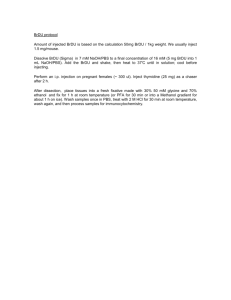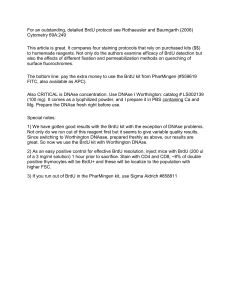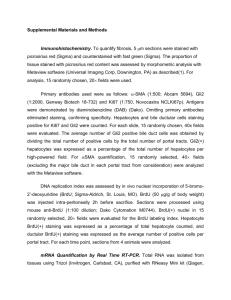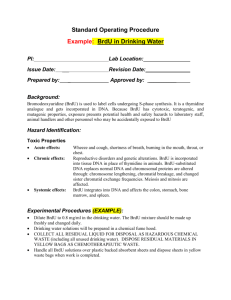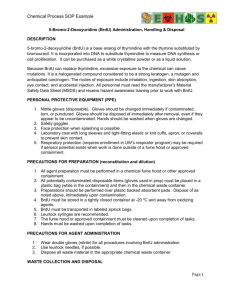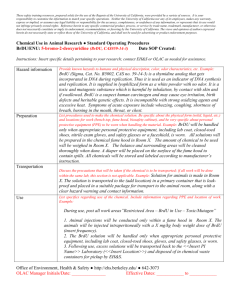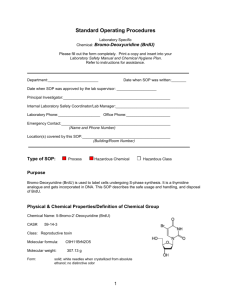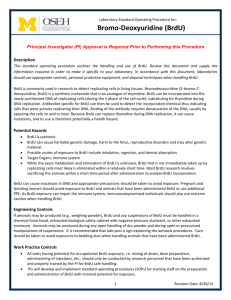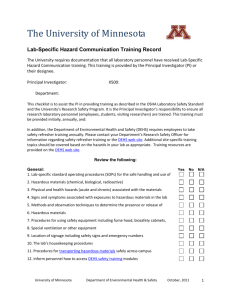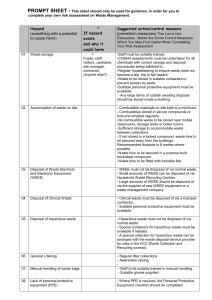BrdU SOP - the Department of Environmental Health & Safety
advertisement
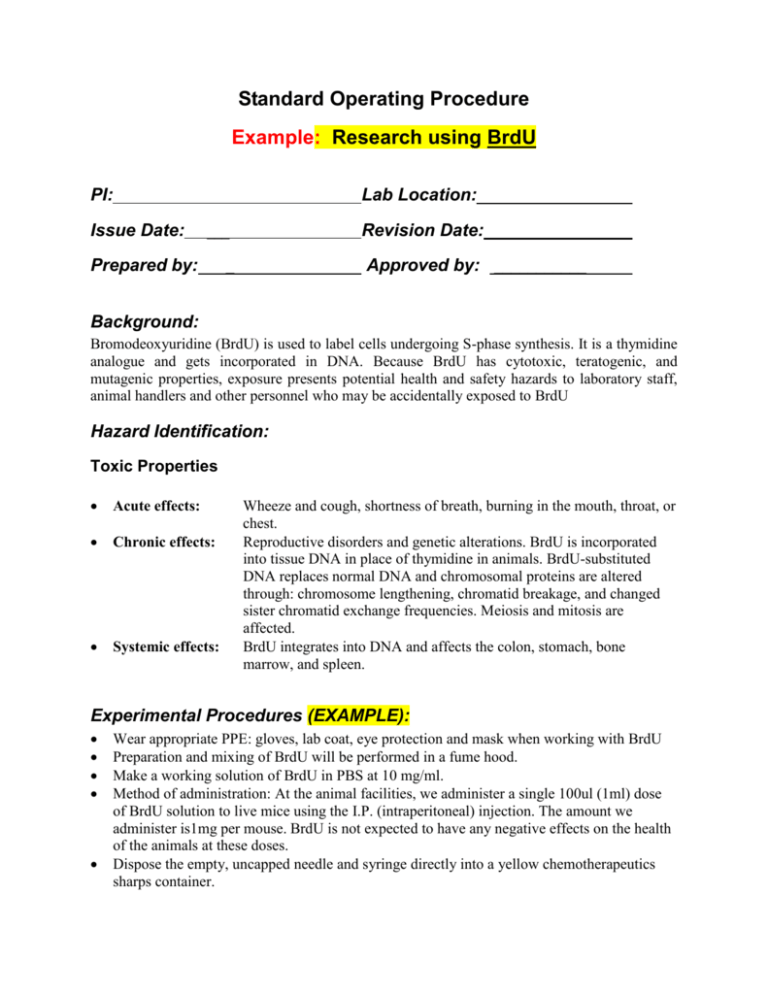
Standard Operating Procedure Example: Research using BrdU PI: Lab Location: Issue Date: Revision Date: ___ Prepared by: Approved by: ___________ _ Background: Bromodeoxyuridine (BrdU) is used to label cells undergoing S-phase synthesis. It is a thymidine analogue and gets incorporated in DNA. Because BrdU has cytotoxic, teratogenic, and mutagenic properties, exposure presents potential health and safety hazards to laboratory staff, animal handlers and other personnel who may be accidentally exposed to BrdU Hazard Identification: Toxic Properties Acute effects: Chronic effects: Systemic effects: Wheeze and cough, shortness of breath, burning in the mouth, throat, or chest. Reproductive disorders and genetic alterations. BrdU is incorporated into tissue DNA in place of thymidine in animals. BrdU-substituted DNA replaces normal DNA and chromosomal proteins are altered through: chromosome lengthening, chromatid breakage, and changed sister chromatid exchange frequencies. Meiosis and mitosis are affected. BrdU integrates into DNA and affects the colon, stomach, bone marrow, and spleen. Experimental Procedures (EXAMPLE): Wear appropriate PPE: gloves, lab coat, eye protection and mask when working with BrdU Preparation and mixing of BrdU will be performed in a fume hood. Make a working solution of BrdU in PBS at 10 mg/ml. Method of administration: At the animal facilities, we administer a single 100ul (1ml) dose of BrdU solution to live mice using the I.P. (intraperitoneal) injection. The amount we administer is1mg per mouse. BrdU is not expected to have any negative effects on the health of the animals at these doses. Dispose the empty, uncapped needle and syringe directly into a yellow chemotherapeutics sharps container. COLLECT ALL RESIDUAL LIQUID FOR DISPOSAL AS HAZARDOUS CHEMICAL WASTE. DISPOSE THE RESIDUAL MATERIAL IN YELLOW BAGS AS CHEMOTHERAPEUTIC WASTE. Handle all BrdU solutions over plastic backed absorbent sheets and dispose sheets in yellow chemotherapeutic waste bags when work is completed. Control Plan: General Controls: Any work with BrdU needs to be done over disposable absorbent benchtop spill pads. Any laboratory equipment or surfaces that have come in contact with BrdU will be decontaminated or disposed of. This can be done by wiping them down with soap and water and paper towels (see Waste Management Procedures for instructions on towel disposal). Non-porous materials, such as glassware, will be decontaminated by soaking in bleach for 24 hours. Engineering Controls: To prevent inhalation, solid/crystalline forms of BrdU will be handled and weighed out in a chemical fume hood or similar exhausted enclosure. (If air currents making handling difficult, a safety shield may be positioned in front of the balance to divert air around the equipment.) Note: If you do not have a fume hood, you must wear an N-95 respirator and participate in the University Of Minnesota’s Respiratory Protection Program. To reduce the chance of accidental injection, syringes and IV sets with Luer-Lok fittings will be used for preparing and administering hazardous drugs. TM Required PPE: To prevent skin exposure, appropriate personal protective equipment (PPE) will be worn when handling any amount of BrdU. Wear a lab coat, disposable gown, or coveralls. Ensure that all exposed skin is covered. Shorts and sandals are not allowed in the lab! Use two pairs of powder-free, disposable nitrile gloves, with the outer one covering the gown cuff whenever there is risk of exposure to hazardous chemicals. Wear ANSI Z-87 approved safety glasses. Wear goggles and a face shield when splashes to the eyes, nose, or mouth may occur. Control Procedures for animal care staff: RAR Area Supervisor will be informed of our intent to use BrdU two weeks prior to use Cages of animals injected with BrdU will be clearly labeled as such All bedding changed during chemical administration and for 72 hours beyond final administration must be collected in yellow bags for disposal Follow PPE and handling requirements specified in the Standard Animal Husbandry Chemical Hazard SOP (attached) Waste Management Procedures: Excess BrdU solids: Dispose as hazardous chemical waste, following procedures detailed in the University’s Hazardous Waste Guidebook. Disposable lab supplies (e.g., gowns, gloves, benchtop pads, etc.,): Collect in yellow bags for incineration. Needles and sharps: Must be disposed of in separate sharps container that is labeled “BrdU Sharps”, sealed and placed in a yellow bag for incineration. Contaminated bedding: Dispose of in yellow bags for incineration. Spill cleanup materials: Place in leak proof container and box for disposal as hazardous waste following procedures detailed in the University’s Hazardous Waste Guidebook. For more information: http://www.dehs.umn.edu/PDFs/Chemo%20Waste%20Disposal%20fact%20sheet.pdf Spill and Accident Procedures: Spill Cleanup Solid: If source container drops and breaks (1-100 grams max), avoid raising dust – do not sweep up dry material. Evacuate spill area, restrict other from entering the area and from a safe spot, call 911 and request AHERPS. If a small amount (<250 mg) spills outside of spill containment, ensure personal protective equipment(PPE) is appropriate (an N-95 respirator if outside of the hood, double-nitrile gloves, goggles, and a lab coat), cover material with paper towels, spray lightly with bleach water solution (10% bleach) and carefully scoop material and paper towels into container for appropriate disposal (see Waste Management Procedures) For amounts in between, use prudent judgment to decide whether to attempt cleanup, or call for spill response. Solution: If BrdU solution should spill, prevent liquid from entering sewer. Apply absorbent pads for larger amounts of liquid and, using appropriate PPE, carefully scoop wetted absorbent material into container for appropriate disposal (see Waste Management Procedures). Accidental Exposures Wash exposed skin with soap & water, flush eyes for 15 min. Call 911 or seek medical attention. For urgent care, employees may go to HealthPartners Occupational and Environmental Medicine (M/F day time or Urgent Care after hours), or UMMCFairview Hospital (24 hrs). You may seek medical attention at the closest available medical facility or your own healthcare provider. Follow-up must be done by HealthPartners Occupational and Environmental Medicine. Report the incident to your supervisor as soon as possible, fill out the appropriate documentation. Employee First Report of Injury Supervisor Incident Investigation Report Note: It is important to fill out all of the appropriate documents to be eligible to collect workers compensation should any complications from the hazardous exposure arise in the future. Report all exposures to supervisor as soon as possible! References: BrdU MSDS from Sigma Aldrich http://www.sigmaaldrich.com/MSDS/MSDS/DisplayMSDSPage.do?country=US&language=en&product Number=B5002&brand=SIGMA&PageToGoToURL=http%3A%2F%2Fwww.sigmaaldrich.com%2Fcata log%2Fproduct%2FSIGMA%2FB5002%3Flang%3Den UCLA: EH&S Staff. “5-Bromo-2-Deoxyuridine FACT SHEET” http://biosafety.ucla.edu/docs/factsheet%20bromodeoxyuridine.pdf Animal Husbandry Chemical Hazard Notification PI Name: PI Phone: IACUC Protocol Number: Emergency Contact Information Name: Work Phone: After-hours Phone Number: Name of Hazard: Hazard Type: (e.g., carcinogen, reproductive toxin, cytotoxic, neurotoxin): Start date and end date of Hazard: PPE for entering room and for handling animals: disposable gown, lab coat and/or scrubs disposable shoe covers or waterproof boots that must be rinsed prior to leaving the room. safety glasses with side shields or face shield gloves disposable head cover N95 or PAPR Other: Instructions for handling bedding: Don PPE listed above. All bedding changed during chemical administration and for 72 hours after the last administration must be collected in yellow chemical waste bags for disposal. Euthanasia (Adhere to the euthanasia method approved in your protocol) For optimal safety, CO2 euthanasia of chemically-treated animals should be done in the following manner: 1. Use an empty, clean box bottom with no bedding in it. Place yellow bag inside as a liner. 2. Follow all steps for humane CO2 euthanasia as posted on the instruction sheet. This sheet is located near the euthanasia station. 3. After confirming the animal is dead, seal the yellow bag, and place it in the nearest cooler. Carcass disposal All carcasses collected during chemical administration and for 72 hours after the last administration must be disposed of in yellow chemical waste bags. NOTES: The above procedures must remain in place while a hazardous chemical is being administered to animals AND for 72 hours after the final administration. Research staff must alert RAR at least two weeks prior to the start of administration of any chemical hazard to animals. Additional instructions:
